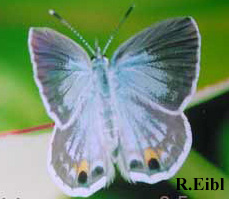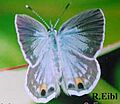Miami blue facts for kids
Quick facts for kids Miami blue |
|
|---|---|
 |
|
| Conservation status | |
| Scientific classification |
|
| Kingdom: | Animalia |
| Phylum: | Arthropoda |
| Class: | Insecta |
| Order: | Lepidoptera |
| Family: | Lycaenidae |
| Genus: | Cyclargus |
| Species: |
C. thomasi
|
| Subspecies: |
C. t. bethunebakeri
|
| Trinomial name | |
| Cyclargus thomasi bethunebakeri W. P Comstock & Huntington, 1943
|
|
| Synonyms | |
|
Hemiargus thomasi bethunebakeri |
|
The Miami blue (Cyclargus thomasi bethunebakeri) is a small butterfly that lives in the coastal areas of southern Florida. It is a special type, or subspecies, of Thomas's blue butterfly. This butterfly was once very common. Now, it is critically endangered, meaning it is in great danger of disappearing forever.
Luckily, a special program at the Florida Museum of Natural History has been helping to increase its numbers. They are doing this through captive breeding, which means raising them in a safe environment.
Contents
What is the Miami Blue Butterfly?
The Miami blue butterfly is a tiny insect. Its wingspan is about 22 to 28 millimeters, which is less than an inch.
How to Identify a Miami Blue Butterfly
- Males: The top side of their wings is a bright, shiny blue color.
- Females: The top side of their wings is dark gray. They have some blue near the base of their wings.
- Both sexes: The underside of their wings is gray. They have a white band on their back wings and four black spots.
Miami Blue Caterpillars and Pupae
- Larvae (caterpillars): These can be light green or even purple.
- Pupae: The pupae, which is the stage before becoming an adult butterfly, can be black or green.
Life Cycle and Reproduction
Female Miami blue butterflies can lay up to 300 eggs. They usually lay one egg at a time. However, you might find more than one egg on the same host plant. A host plant is a specific plant that the butterfly's caterpillars eat.
How Long Does it Take to Grow?
Most of the year, an adult butterfly will emerge from its pupa about 30 days after the egg was laid. You can see adult Miami blue butterflies all year round. They have many generations that overlap from May to November. There is also a winter generation from December to April. During winter, some adults and pupae go into a resting state called diapause.
What Plants Do They Use?
Miami blue butterflies use different plants to lay their eggs. These are called host plants.
- Older reports say they used grey nickerbeans (Caesalpinia bonduc) and blackbeads (Pithecellobium species).
- Since the 1970s, balloonvines became common host plants. These include the native Cardiospermum corindum and the introduced Cardiospermum halicacabum.
- Recently, butterflies found in the Key West National Wildlife Refuge prefer the Florida Keys blackbead (Pithecellobium keyense).
- Other plants they might use are peacock flower (Caesalpinia pulcherrima), snowberry (Symphoricarpos), and cat's-paw blackbead (Pithecellobium unguis-cati).
Where Do Miami Blue Butterflies Live?
The Miami blue butterfly is the only type of Cyclargus thomasi found in the United States.
Historical Range of the Miami Blue
Before the late 1900s, the Miami blue butterfly lived in a large area of Florida. This stretched from Daytona Beach in the north, all the way south around the tip of the peninsula, and up to the Tampa Bay area. They also lived throughout the Florida Keys to the Dry Tortugas.
Their natural homes include the edges of tropical hardwood hammocks, scrub areas, and pine rocklands.
Current Range and Decline
The Miami blue butterfly has also been seen in Bimini and sometimes in other parts of The Bahamas.
However, in the second half of the 20th century, the number of Miami blue butterflies dropped a lot. This was mainly because their habitat was lost due to new buildings and cities. By 1990, they had disappeared from mainland Florida and the islands along the coast. They were only found in a few places in the Florida Keys. Then, Hurricane Andrew in 1992 seemed to wipe out almost all of them.
Miami blue butterflies do not travel far. Adults are usually found very close to where they were first seen.
Conservation Efforts and Breeding Programs
In 1999, a small group of Miami blue butterflies was found in Bahia Honda State Park. Experts thought there were fewer than fifty butterflies left.
Protecting the Miami Blue
- In 2002, the Florida Fish and Wildlife Conservation Commission temporarily listed the Miami blue as endangered.
- This 'endangered' listing was made permanent in 2003.
- Searches for other groups of Miami blues did not find any more at that time.
Raising Butterflies to Help Them Survive
In 2003, the University of Florida started a program to raise and breed Miami blue butterflies. They began with about 100 eggs collected from the wild.
- In 2004, they released 2,500 butterflies in specific locations.
- In 2006, hundreds of caterpillars and adult butterflies raised in captivity were released on Elliott Key in Biscayne National Park.
- Miami blues have also been reintroduced to Everglades National Park and Dagny Johnson Key Largo Hammock Botanical State Park. However, most of these attempts before May 2009 were not successful.
New Discoveries
In late 2006, more groups of Miami blue butterflies were found on Boca Grande Key and the Marquesas Keys. These areas are part of the Key West National Wildlife Refuge. The group at Bahia Honda died out in 2010. Because of this, conservation efforts then focused on the butterflies in the Key West National Wildlife Refuge. In 2016, another group of breeding Miami blue butterflies was found in the Great White Heron National Wildlife Refuge.
The Miami blue butterfly is listed as an Endangered species by both the State of Florida and the Federal government.
Images for kids



